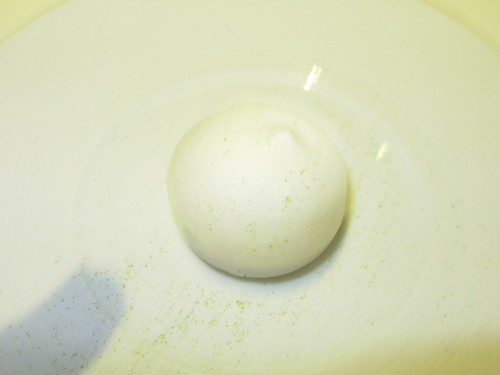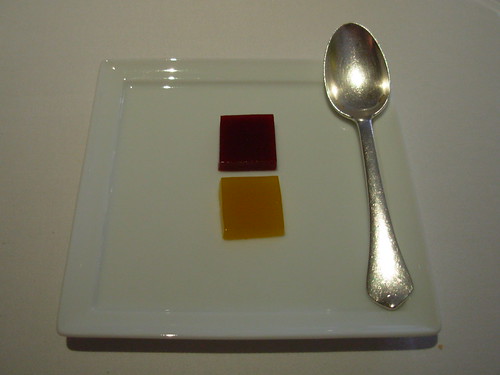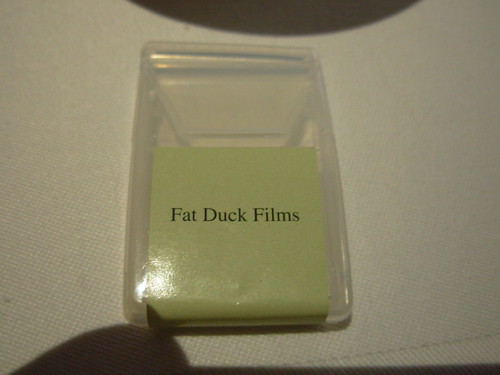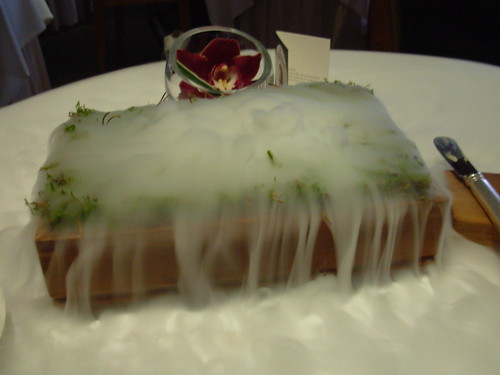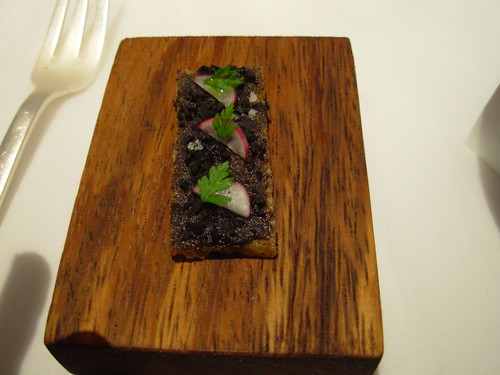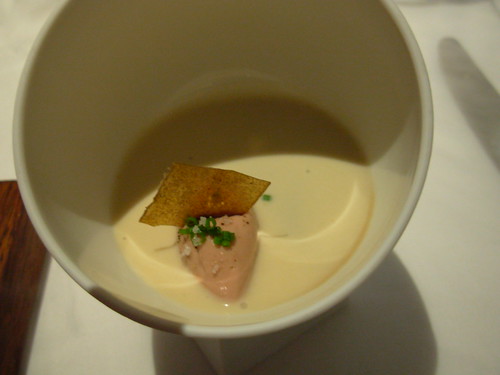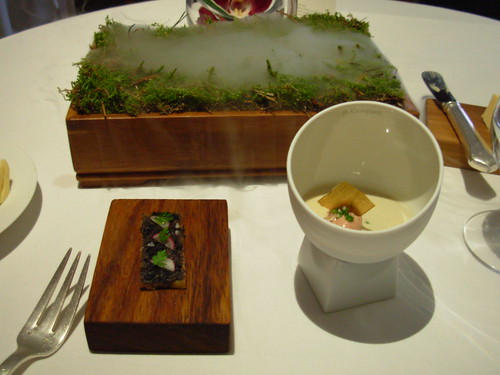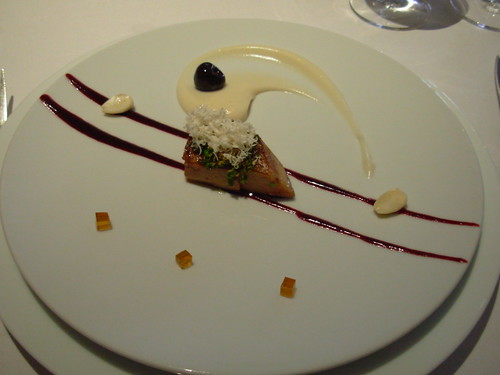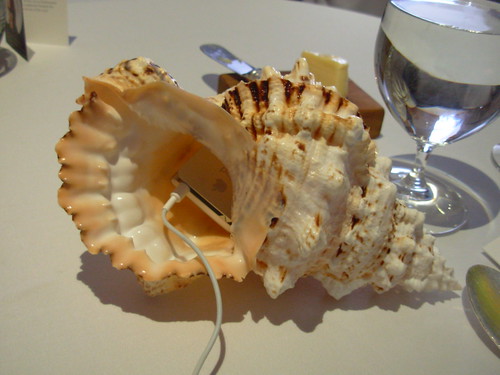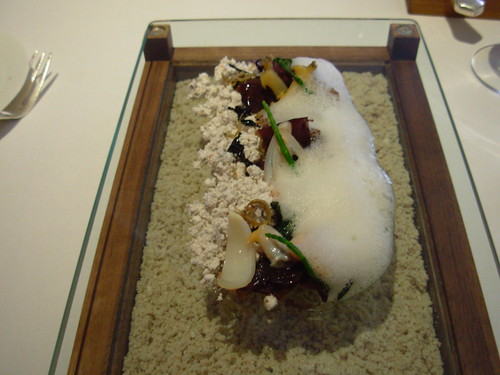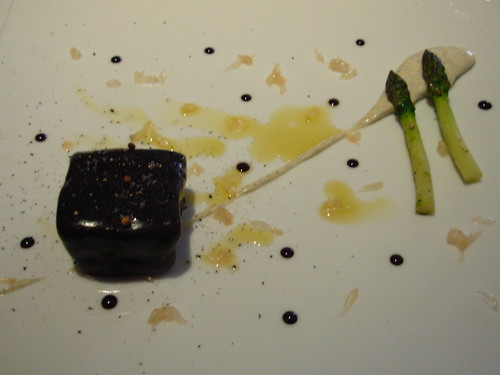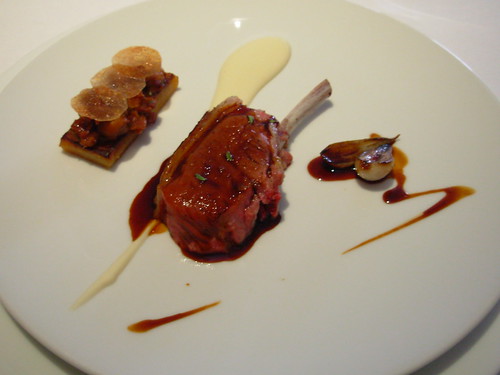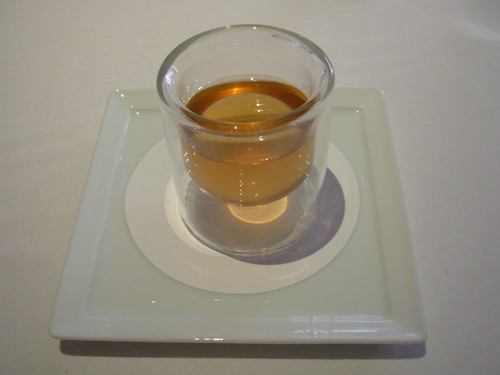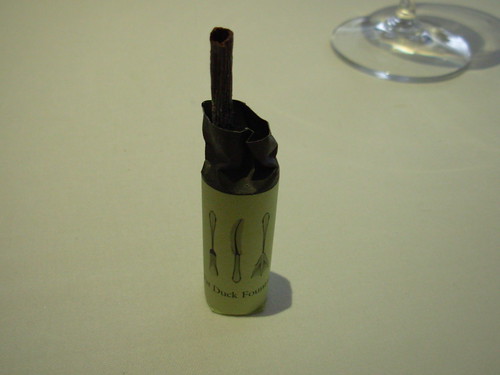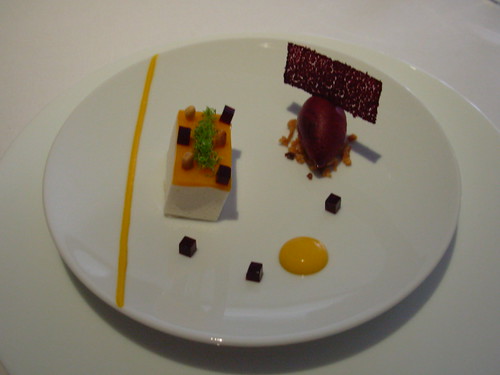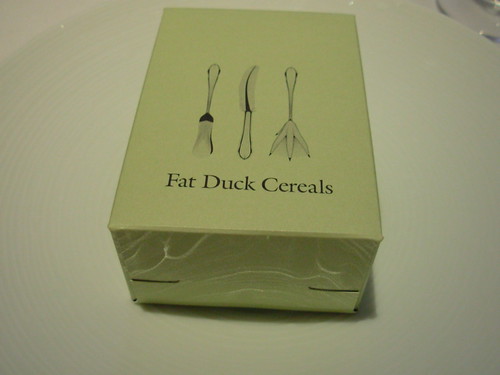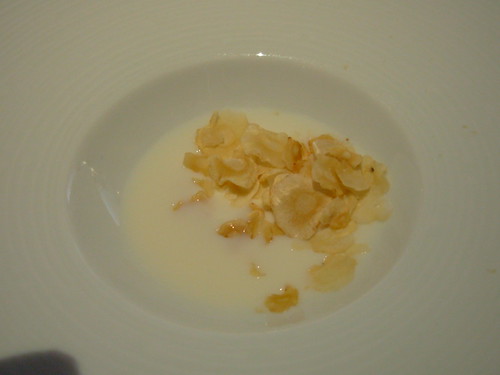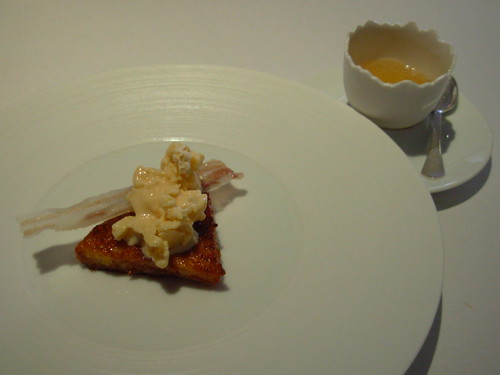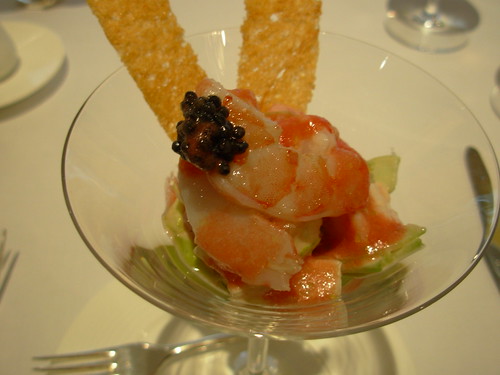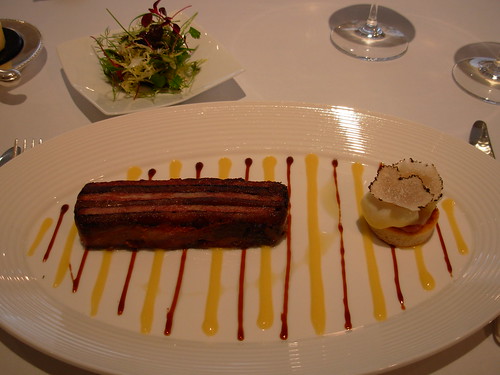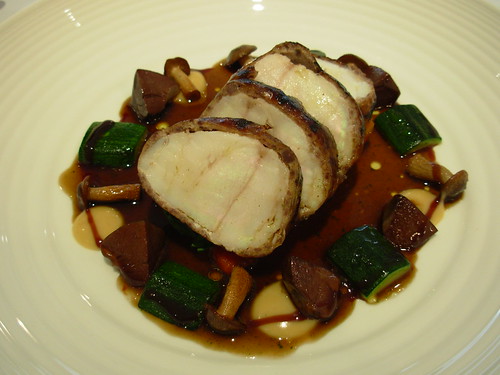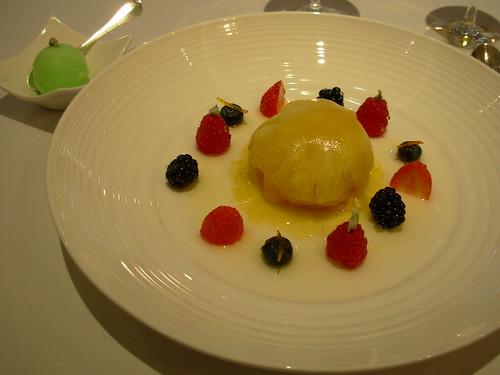Having friends in high places can challenge restaurant criticism. I recently was invited to spend three minutes asking a question at a Ph.D. oral in Utrecht for which my transportation, hotel, and most meals were paid, plus an honorarium that paid me several Euros for each second of talk. Me and Ms. Hilton, what scammers. With this kind of largess, I decided to blow my pay packet on dinner at Oud Sluis, one of a Dutch trio of Michelin three star restaurants, and the establishment that under the leadership of chef Sergio Herman is making the greatest impact on global dining. I planned my trip carefully, wishing on the one hand to indulge and on the other to be a just and tough-minded critic. But a friend with tasty connection with Chef Herman arranged a special dinner, a plot that I only discovered on my arrival. My evening was an extension and intensification of what other diners might experience.
Oud Sluis is a treasure, much in the culinary style of Per Se/French Laundry, a restaurant that is much aware of the latest trends in molecular cuisine, but, unlike The Fat Duck or Alinea or El Bulli, does not fetishize the odd and abnormal, but uses those techniques along with more classical preparations. Herman is a chef who wishes to explore the savory but without permitting strong flavors to brutalize subtle flavors. He embraces the complex and the whimsical in ways that often succeed gloriously. If there is a caution, it is that Chef Herman is still in process of developing a uniquely personal style and a singular astonishing signature dish, although the entire menu and several presentation reveal considerable culinary facility. After three weeks I can still recall vividly some of Herman's creations, always an important sign. Chef Herman is young and some of the thematic linkages of the meal may have been lost in the generous blizzard of courses I was gifted. But my meal was superior to recent meals at Le Bernardin and Alain Ducasse in New York and the equal of those at Gordon Ramsay and Joel Robuchon.
Perhaps it was due to my connections that service was impeccable, although as best I could tell those diners sitting near me were happily and efficiently chowing down. The restaurant, comfortable, modern, and spare, with an emphasis on light woods and black trim, was attractive in itself, although not so architecturally fluent that one would visit for the decor.
The adventure began with a startling starter. Since these dishes were "off the menu," my descriptions may be less adequate than acceptable on a website of record. The first offering was buckwheat spaghetti with mackerel, marinated in lime and pepper, served beneath an orb of wasabi-sake ice. This aperitif glass was platonic, wakening one's taste buds while revealing the chef's philosophy: a willingness to play with strong tastes (mackerel, lime, wasabi, buckwheat), while moderating them in practice. Despite what might have been a set of clashing tastes and textures, the melding was pure joy.
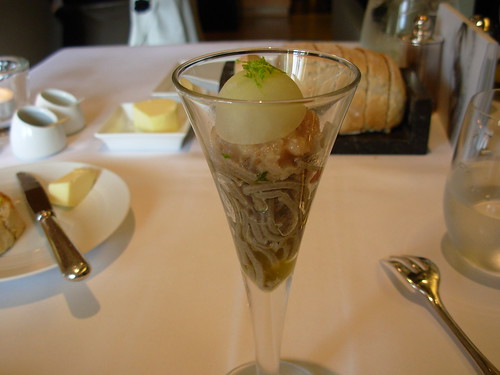
My second opener was a simple cup of aioli with thin crostini. The crostinis of fragile sourdough crust were extravagantly crackly. The garlicky aioli was mixed as an airy cloud. As with the mackerel, this dish played with the strong taste of garlic, but lightened its texture and flavor.

Just over the Dutch border, Chef Herman next teased national expectations, producing a Brussel Waffle. This small pleasure was marinated herring tucked inside a mini-waffle, decorated with dots of curry and avocado cream. The theme of the meal becomes ever clearer: herring and curry, but moderated with cream and wheat. Smooth and rough. This four-bite starter was quite lovely, each bite, both those curried and those floral and nutty green.

The fourth offering was a Tiffany gem: a gustatory bon bon infused with a puree of Granny Smith apple and a liquid foie gras. The presentation literally bursted with aqueous flavor. This jewel was among the most impressive construction that I have eaten, a surprise that was beautiful to espy, startling to consume, and evocative in memory: rich liver and tart apple, held together by some enlightened gelatin that did not feel or taste like tired and rubbery aspic.
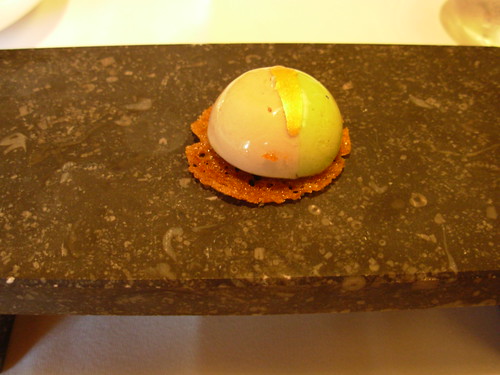
This was followed by a double tribute to Chefs Keller and Adria: nitrogenated emulsion of "oyster caviar." It lacked the lushness of Keller's "Oysters and Pearls," but the flinty pearls were more mature than, say, "Caesar Salad Dipping Dots." If one must have such frozen treats, oyster pearls made a lively and amusing choice.

Next I was presented with a salad tasting: 1) marinated salmon, champagne, dill and asparagus, 2) a salad of potatoes and shallots, 3) A marinated cucumber salad of lobster and radicchio on cracker, and 4) ratatouille with a espuma of escoviche (a Jamaican snapper). Although I found the potato salad less compelling, the other three were excellent. This is a chef who uses foam carefully, adding an edge of fish to his vegetables. The marinated salmon was a lovely take on lox in a modern style. Of the quartet it was the lobster that captured through its luxury - a postage stamp salad that could be sent anywhere.
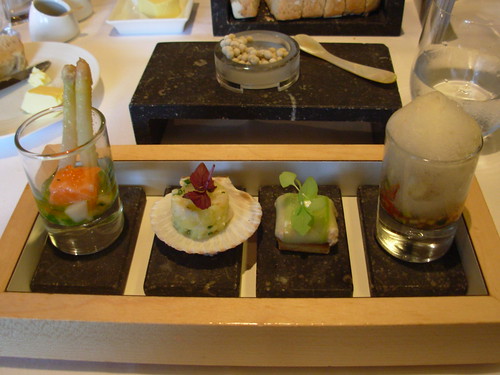
Finally the menu, as printed, began. First, Tomato Structures with Marinated Gamba, Basil, Sorbet of Cabernet-Sauvignon Vinegar and Olive Oil Powder. I love fresh tomatoes, but I adored the single cherry tomato that was infused with oil and vinegar: the single best tomato on earth. The remaining four structures, although otherwise notable, didn't stand a chance. They were bystanders.
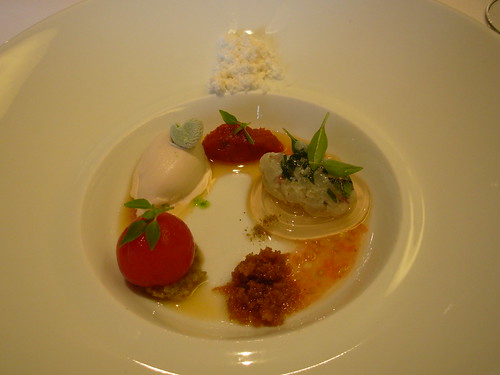
The next dish was my star of the evening, a tartare of langoustine with an emulsion of olive oil and yuzu, with caviar, seafood jelly, and cream of sea vegetables. This rather complex dish (and like Tom Keller, Sergio Herman is partial to complexity - except the above-mentioned cherry tomato) was a brave medley of tastes and textures. The fruity, herbal, salty, and buttery notes were symphonic. Even though complex, the dish had an astonishing lightness of being. Herman's strong tastes did not overpower.
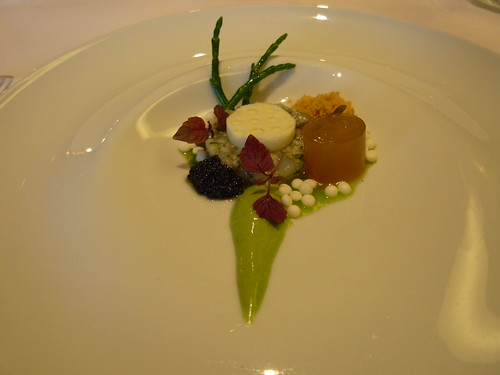
This was quickly followed with a foamy turbot: turbot with verbena and "barigoul (artichoke farci) foam" with pan-fried langoustine and tempura of verbena. This was another complex langoustine dish that tamed the savory to good effect. Perhaps the turbot is not as joyous a fish as some, but this was an astonishing and beautiful plate that successful melded fish and crustacean.
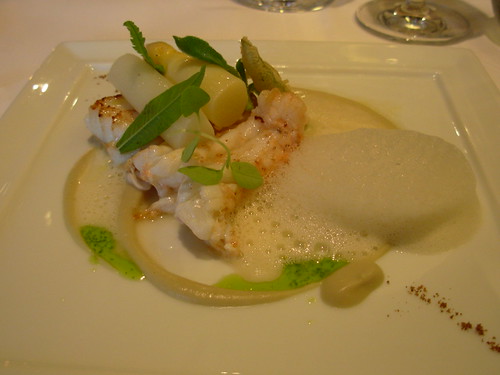
In short order we moved from langoustines to lobster: "Bomba rice" paella with Zealand lobster, chorizo and slowly cooked squid with a sauce of crustaceans and cremolata of peas. Another ravishing and complex dish. Yet, this was the dish that I found disappointing. In comparing this deconstruction to a more traditional paella, my strong preference was for the latter. This was a stripped-down, constricted paella. When deconstructing tradition - "paella" - a chef needs to insure that the quotation marks add value. One can hardly complain about perfectly prepared lobster, but the dish felt cramped and theoretical; it lacked integrity as a tribute.
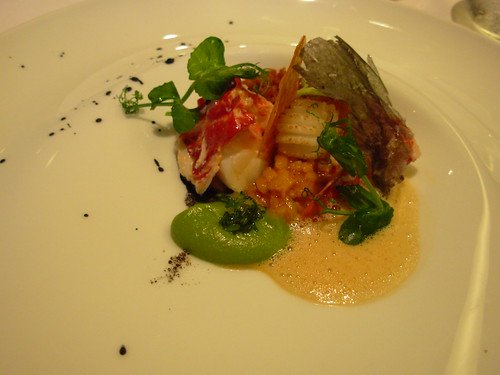
The palate cleanser was cucumber three-way: jellied, foamy, and marinated, served as a cocktail. Cucumber when prepared right is God's treat of summer: the refreshment of Eden. This break was glorious.
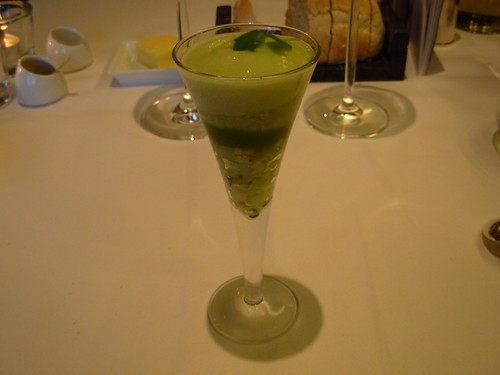
The single meat course was lamb "Sisteron" with courgette (zucchini) flowers, lamb sauce, Parmesan jelly and "poudre d'or." Granted the gold powder was a conceit of a culture with too much disposable income, but the lamb was ideally cooked - juicy and moist, fully lamby - but with a startlingly crispy crust that must have taken some thoughtful effort to achieve. The strip of cheese preserves was good fun. If not the most compelling dish of the night, it was a straight-forward center-piece with memorable twists and turns.

This brings a diner to a trio of dessert courses with their own variants: structures of chocolate and caramel with ice cream from salted peanuts; almond biscuit with strawberries and ice cream of elderberry flower; and preparations of raspberry and coconut. At some restaurants desserts are an afterthought, but desserts at Oud Sluis contain the same attempt to tame the savory, and they largely work. I particularly admired the chocolate cream with passion fruit. The fruit was ripe and robust and the elderberry sorbet was well made. Viewing the photographs reveals a pastry chef who works in the same register as the chef: tart complexity, shaped and channeled by an insistence on subtlety.
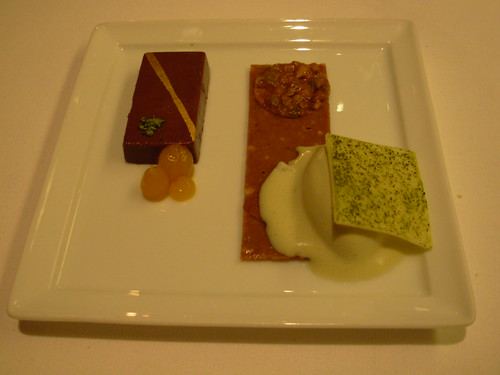
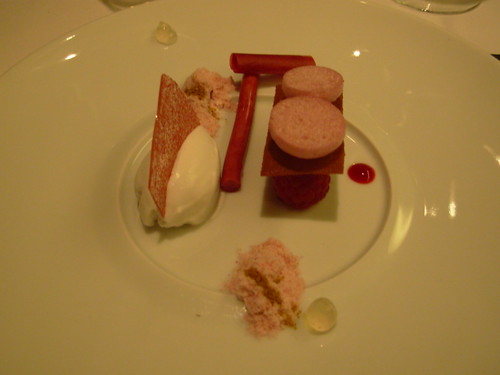
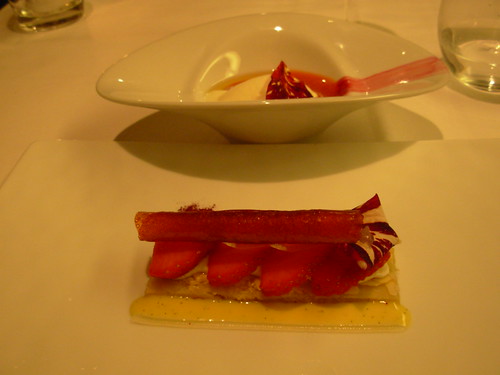
Oud Sluis deserves the praise it has received. And with a young chef who is still developing his own culinary style, it is likely to improve, although no fourth Michelin star will be in the offing. Oud Sluis may lack the explosive flash and gunpowder of the Fat Duck or Alinea, but it reveals a culinary mind. Today every ambitious young chef is a student of Thomas Keller, but some students are more attentive than others. If Sergio Herman is not a teacher's pet, he is a diner's pet.
At high-end restaurants no meal is truly typical, but thanks to an expansive chef my meal was less typical than some, thanks to the soft kindnesses of my network. Yet, the vision and care of Oud Sluis is sure to be evident for every diner, even those not so well connected as this diner-in-full.
Restaurant Oud Sluis
Beestenmarkt 2
Sluis THE NETHERLANDS
(0031) 0117 46 12 69
http://www.oudsluis.nl

